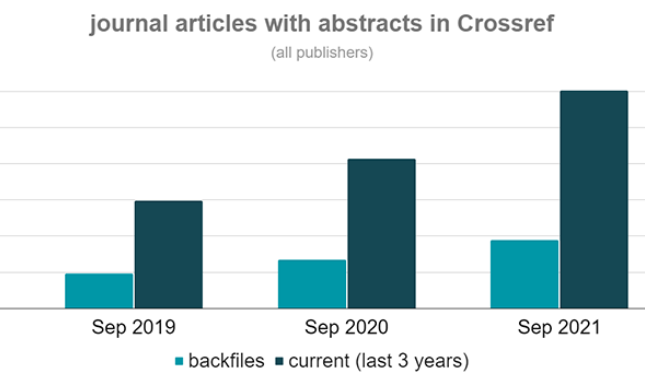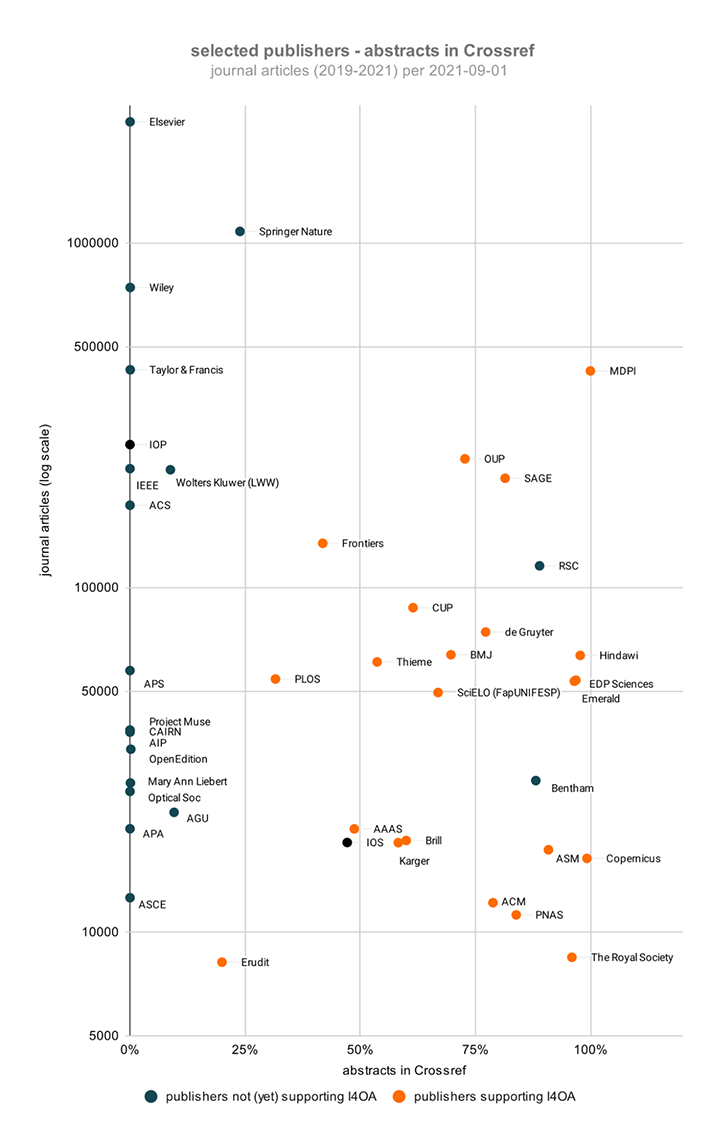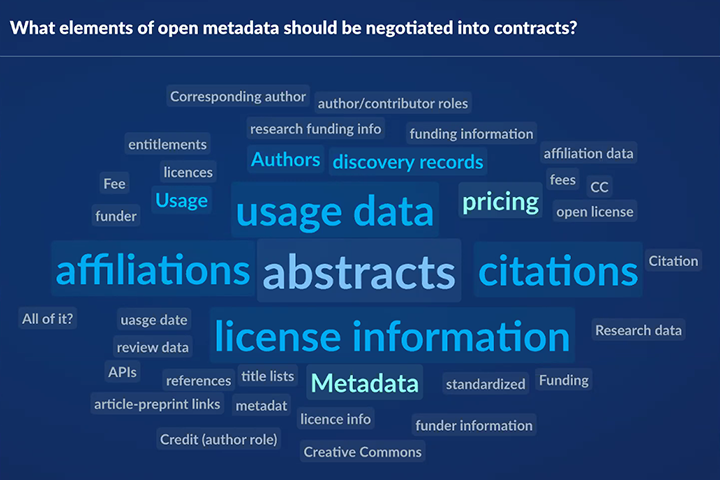The Initiative for Open Abstracts: Celebrating our first anniversary
In this blog post, Ludo Waltman, Bianca Kramer, and David Shotton, co-founders of the Initiative for Open Abstracts, celebrate the first anniversary of the initiative.
On September 24 last year, the Initiative for Open Abstracts (I4OA) was launched. We started the initiative together with a group of colleagues working in the publishing industry, for scholarly infrastructure organizations, at university libraries, and at science studies research centers. I4OA called on scholarly publishers to make the abstracts of their published works openly available in a suitable infrastructure, preferably by submitting them to Crossref, and it continues to make this call. Openness of abstracts makes scholarly outputs easier to discover, it enables new types of research analytics, and it supports science studies research.
In this blog post, we celebrate the first anniversary of I4OA by summarizing the progress made so far and by discussing how I4OA fits into the broader landscape of many ongoing developments toward increased openness of the metadata of scholarly outputs.
How much support for open abstracts do we have?
When I4OA was launched one year ago, the initiative was supported by 40 publishers, including Hindawi, Royal Society, and SAGE, who are founding members of the initiative. Among the initial supporters of I4OA there were commercial publishers (e.g., F1000, Frontiers, Hindawi, MDPI, PeerJ, and SAGE), non-profit publishers (e.g., eLife and PLOS), society publishers (e.g., AAAS and Royal Society), and university presses (e.g., Cambridge University Press and MIT Press). Some of the initial supporters of I4OA are open access publishers, while others publish subscription-based journals.
Over the past year, the number of publishers supporting I4OA has more than doubled. The initiative is currently supported by 86 publishers. Publishers that have joined I4OA over the past year include ACM, American Society for Microbiology, Emerald, Oxford University Press, and Thieme. I4OA has also been joined by a substantial number of national and regional publishers, for instance from countries in Latin America, Eastern Europe, and Asia.
In addition to this, I4OA is supported by a large number of stakeholders in the research system, including many scholarly infrastructure providers.
However, Elsevier, Springer Nature, Wiley, and Taylor & Francis, the four largest publishers in terms of the number of published works, have not yet joined I4OA. These publishers appear to monetize their abstracts by selling them to abstracting services, and they seem to fear that joining I4OA may cause them to lose these revenue streams. Elsevier might also perceive openness of abstracts as a competitive threat to its Scopus business. Elsevier, Wiley, and Taylor & Francis have not yet submitted any abstracts to Crossref, while Springer Nature has started to submit abstracts, but only for its open access content.
How many open abstracts do we have?
On September 1, 12.3% of the 89.4 million journal articles indexed by Crossref had an open abstract. Focusing on the so-called current content in Crossref (i.e., content from the last three years), the share of journal articles with an open abstract is substantially higher. Of the 12.1 million journal articles in the period 2019-2021, 30.1% had an open abstract.
Figure 1 shows the increase over the past few years in the percentage of journal articles in Crossref that have an open abstract. For current content, this percentage increased from 14.9% in September 2019 to 30.1% in September 2021, clearly showing the effect of I4OA. For backfiles (i.e., content that is at least three years old), the increase is more modest, from 4.8% in September 2019 to 9.5% in September 2021. This increase reflects the efforts made by several publishers (including Hindawi, Royal Society, and SAGE, three founding members of I4OA) to make abstracts openly available not only for their new content but also for all their older content.

The above statistics are specifically about journal articles. Looking at all content types in Crossref, including proceedings articles, book chapters, and books, the share of open abstracts is somewhat lower. On September 1 this year, 24.8% of the current content and 7.3% of the backfiles had an open abstract.
Figure 2 provides a breakdown by publisher of the percentage of journal articles in Crossref in the period 2019-2021 that have an open abstract (horizontal axis). The figure also shows the total number of journal articles of a publisher in the period 2019-2021 (vertical axis; logarithmic scale).

Publishers that support I4OA, colored orange in Figure 2, tend to have a high percentage of journal articles with an open abstract. They typically do not reach 100%, because some of the content they publish does not have an abstract. There are a few publishers that only recently started to open their abstracts, so for these publishers the percentage of open abstracts is still relatively low. Publishers that have not yet expressed support for I4OA are colored blue in Figure 2. Most of them have a low percentage of open abstracts, and many do not have any open abstracts at all.
The progress made by individual publishers in opening their abstracts can be clearly seen by comparing Figure 2 with a similar figure published in this blog post last year.
What else happened over the past year?
A very positive development in the past year are the accomplishments of the Initiative for Open Citations (I4OC), a sister initiative of I4OA that campaigns for publishers to make the references of their published works openly available in Crossref. In the first half of 2021, Elsevier, American Chemical Society, and Wolters Kluwer all opened their references. With the exception of IEEE, all major publishers now support I4OC. This development seems to show that most publishers recognize the importance of making the metadata of their published works openly available, suggesting that many of them may also want to join I4OA.
A less positive development was the announcement made last May that Microsoft Academic will be discontinued at the end of the year. At the moment, Microsoft Academic is the most important data source for open abstracts. As shown in a recent presentation by two of the I4OA founders, more than half of the scholarly outputs indexed both by Microsoft Academic and by Crossref have an open abstract in Microsoft Academic. Only 10% of these outputs have an open abstract in Crossref. Hence, the discontinuation of Microsoft Academic will greatly reduce the availability of open abstracts, unless publishers take up their responsibility to submit abstracts to Crossref. OurResearch, which is building a replacement for Microsoft Academic, has already announced that it will only be able to make abstracts available if publishers submit them to Crossref (or PubMed).
Another important development is the growing adoption of the Principles of Open Scholarly Infrastructure (POSI). These principles aim to ensure that scholarly infrastructures serve the interests of the scholarly community, and they reduce the risk of the scholarly community losing its key infrastructures (as is happening right now with Microsoft Academic). The POSI principles have been adopted by Crossref and OpenCitations, two founding members of I4OA. OurResearch, mentioned above, has also expressed a commitment to these principles. By adopting the POSI principles, these infrastructure organizations have made a clear commitment to serve the interests of the scholarly community and to ensure the long-term availability of scholarly metadata.
Next steps
In light of the closure of Microsoft Academic at the end of the year, it is more important than ever to get broad support for I4OA. This is further reinforced by the increasing dependence of research analytics on abstracts. While research analytics based on citations continue to play an important role in research assessments and research on research (e.g., topic mapping, analyzing emerging trends and research fronts), the need to broaden the analytical toolbox is widely recognized. Many providers of research analytics are introducing new indicators and tools. In particular, analytics for assessing the contribution of research to the UN sustainable development goals (SDGs) are attracting a lot of attention (e.g., in the Times Higher Education Impact Rankings). These analytics typically identify SDG-related research by searching for specific terms (e.g., ‘climate change’, ‘hunger’, ‘poverty’, and so on) in the titles and abstracts of scholarly outputs. Openness of abstracts is essential to develop a proper understanding of what these analytics do and do not tell us, and to make sure these analytics are used in a responsible way.
Publishers carry the primary responsibility for making abstracts openly available. We therefore call on publishers that do not yet support I4OA to join the initiative and to open their abstracts. The I4OA team is available to answer questions about the initiative and to provide help to publishers that want to join. Do not hesitate to contact us.
We also encourage other stakeholders in the research system to actively support openness of abstracts. As shown in Figure 3, in a recent Metadata 20/20 webinar, participants mentioned abstracts as the most important metadata element for which openness should be an essential requirement in negotiations with publishers. This highlights the crucial contribution that research institutions and research funders can make by mandating openness of abstracts in their agreements with publishers.

Figure 3. Metadata elements to be negotiated with publishers, as discussed by participants in a recent Metadata 20/20 webinar.
This blog post is published under a CC BY 4.0 license.





0 Comments
Add a comment